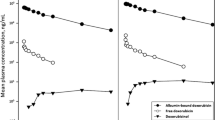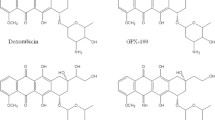Summary
The pharmacokinetics and metabolism of 4-demethoxydaunorubicin (idarubicin, IDA) were studied in 21 patients with advanced cancer after i.v. (12 mg/m2) and oral (30–35 mg/m2) treatment according to a balanced crossover design. Patients were divided into four groups: subjects who showed normal liver and kidney function (group N), those who presented with normal kidney function and liver metastases (group L), those with kidney dysfunction (creatinine clearance, ≤60 l/h; group R), and those with both liver and kidney dysfunction (group LR). Five patients showed variations in liver or kidney function after the first treatment and were considered to be nonevaluable for the crossover study but evaluable for the liver/kidney function study; some of them appeared in different groups for the i.v. as opposed to p.o. treatments. After i.v. administration, IDA plasma levels followed a triphasic decay pattern. The main metabolite observed in all patients was the 13C-reduced compound (IDAol), which attained plasma levels 2–12 times higher than those of the parent compound. IDA pharmacokinetics was not dependent on the presence of liver metastases but was related to the integrity of kidney function. Analysis of variance indicated a significant correlation between IDA plasma clearance and creatinine clearance; it was also found that IDA plasma clearance was lower in patients whose creatinine clearance was <60 ml/min [group N, 122.8±44.0 l/h; group L, 104.4±27.7 l/h (P=0.58) vs group R, 83.4±18.3 l/h (P=0.037)]. The IDAol terminal half-life and mean residence time (MRT) were significantly increased in patients with impaired kidney function [MRT: group N, 63.6±10.8 h; group L, 69.9±10.2 h (P=0.27) vs group R, 83.2±10.9 h (P=0.025) andt 1/2γ: group N, 41.3±10.1 h; group L, 47.0±7.4 h (P=0.31) vs group R, 55.8±8.2 h (P=0.025)]. After oral treatment, drug absorption occurred during in the first 2–4 h after IDA administration; a biphasic decay pattern was observed thereafter. The main metabolite observed in all patients was again IDAol. The AUC of IDAol was greater after oral administration than after i.v. treatment in proportion to the AUC of IDA (i.v.: AUC-IDAol/AUC-IDA, 2.4–18.9; p.o.: AUC-IDAol/AUC-IDA, 4.1–21.4). Following oral dosing, a substantial amount of 4-demethoxydaunomycinone (AG1) was found in 11/21 patients. No AG1 was detected after i.v. treatment, nor was the corresponding aglycone derived from IDAol found after p.o. or i.v. administration. IDA bioavailability, computed as the ratio of the dose-corrected AUC after p.o. and i.v. treatments in the same patient, was in the 25.2%–35.7% range for groups N, L, and R. Group LR showed a significantly reduced IDA bioavailability (15.7%±5.2%). However, a better description of the actual bioavailability was obtained by taking into account the AUCs of both IDA and IDAol after i.v. and p.o. administration and the relative potency of the two compounds.
Similar content being viewed by others
References
Akaike H (1974) A new look at the statistical model identification. IEEE Trans Automat Contr 19: 716–723
Berman E, Wittes RE, Leyland-Jones B, Casper ES, Gralla RJ, Howard J, Williams L, Baratz R, Young CW (1983) Phase I and clinical pharmacology studies of intravenous and oral administration of 4-demethoxy daunorubicin in patients with advanced cancer. Cancer Res 43: 6096–6101
Camaggi CM, Strocchi E, Tamassia V, Martoni A, Giovannini M, Iafelice G, Canova N, Marraro D, Martini A, Pannuti F (1982) Pharmacokinetic studies of 4′-epidoxorubicin in cancer patients with normal and impaired renal functions and with hepatic metastases. Cancer Treat Rep 66: 1819–1824
Camaggi CM, Strocchi E, Martoni A, Angelelli B, Comparsi R, Pannuti F (1985) Epirubicin plasma and blood pharmacokinetics after single IV bolus in advanced cancer patients. Drugs Expt Clin Res 11: 285–294
Camaggi CM, Comparsi R, Strocchi E, Testoni F, Angelelli B, Pannuti F (1988) Epirubicin and doxorubicin comparative metabolism and pharmacokinetics. Cancer Chemother Pharmacol 21: 221–228
Camaggi CM, Carisi P, Strocchi E, Pannuti F (1992) High-performance liquid chromatographic analysis of idarubicin and fluorescent metabolites in biological fluids. Cancer Chemother Pharmacol 30: 303–306
Casazza AM, Barbieri B, Fumagalli A, Geroni MC (1983) Biologic activity of 4-demethoxy-13-dihydrodaunorubicin. Proc Am Assoc Cancer Res 24: 251
Comis RL, Issell BF, Pittmann K, Ginsberg SJ, Rudolph A, Aust JC, Fino SM, Tinsley RW, Poiesz BJ, Crook ST (1982) A phase I and clinical pharmacology study of intravenously administered carminomycin in cancer patients in the United States. Cancer Res 42: 2944–2948
Daghestani AN, Arlin ZA, Leyland-Jones B, Gee TS, Kempin SJ, Mertelsmann R, Budman D, Schulman P, Baratz R, Williams L, Clarkson BD, Young CW (1985) Phase I and II clinical and pharmacological study of 4-demethoxy daunorubicin (idarubicin) in adult patients with acute leukaemia. Cancer Res 45: 1408–1412
De Gregorio MW, Carrera CJ, Klock JC, Pegelow CM, Wilbur JR (1982) Cellular and plasma kinetics of daunorubicin given by two methods of administration in a patient with acute leukaemia. Cancer Treat Rep 66: 2085–2088
Dixon WJ, Brown MB (1979) BMDP-79 biomedical computer programs, P-series. University of California Press, Berkeley
Draper N, Smith H (1966) Applied regression analysis. J Wiley, New York
Eadie WT, Drijard D, James FE, Roos M, Sadoulet B (1971) Statistical methods in experimental physics. North-Holland, Amsterdam
Ganzina F, Pacciarini MA, Di Pietro N (1986) Idarubicin (4-demethoxydaunorubicin). A preliminary overview of preclinical and clinical studies. Invest New Drugs 4: 85–105
Gibaldi M, Perrier D (1982) Pharmacokinetics. Marcel Dekker, New York
Gillies HC, Herriott D, Liang R, Ohashi K, Rogers HJ, Harper PG (1987) Pharmacokinetics of idarubicin (4-demethoxy daunorubicin, IMI-30, NSC 256439) following intravenous and oral administration in patients with advanced cancer. Br J Clin Pharmacol 23: 303–310
James F, Ross M (1983) MINUIT D506. Function minimization and error analysis. CERN Computer Centre Program Library Geneve
Kaplan S, Martini A, Varini M, Togni P, Cavalli F (1982) Phase I trial of 4-demethoxy daunorubicin with single i.v. doses. Eur J Cancer 18: 1303
Lu K, Savaraj N, Kavanagh J, Feun LG, Burgess M, Bodey GP, Loo TL (1986) Clinical pharmacology of 4-demethoxydaunorubicin (DMDR). Cancer Chemother Pharmacol 17: 143–148
Manaka RC, Schumitzky A, Wolf W (1981) Symbolic programs for structural identification of linear pharmacokinetic systems. Comput Progr Biomed 13: 203–213
Milroy R, Cummings J, Kaye SB, Banham SW (1987) Phase II clinical and pharmacological study of oral 4-demethoxydaunorubicin in advanced non-pretreated small-cell lung cancer. Cancer Chemother Pharmacol 20: 75–77
Pannuti F, Camaggi CM, Strocchi E, Comparsi R, Angelelli B, Pacciarini MA (1986) Low dose oral administration of 4-demethoxydaunorubicin (idarubicin) in advanced cancer patients. A pharmacokinetic study. Cancer Chemother Pharmacol 16: 295–299
Robert J, Rigal-Huguet F, Huet S, Pris J, Hurteloup P (1990) Pharmacokinetics of idarubicin after oral administration in elderly leukemic patients. Leukemia 4: 227–229
Rowland M (1988) Bioavailability assessment and pharmacologic response: impact of first-pass loss when both drug and metabolites are active. J Pharmacokinet Biopharm 16: 573–593
Smith DB, Margison JM, Lucas SB, Wilkinson PM, Howell A (1987) Clinical pharmacology of oral and intravenous 4-demethoxydaunorubicin. Cancer Chemother Pharmacol 19: 138–142
Taylor JR (1982) An introduction to error analysis. The study of uncertainties in physical measurements. University Science Books, Princeton
Yamaoka K, Nakagawa T, Uno T (1978) Application of Akaike's Information Criterion (AIC) in the evaluation of linear pharmacokinetic equations. J Pharmacokinet Biopharm 6: 165–175
Zanette L, Zucchetti M, Freshi A, Erranti D, Tirelli U, D'Incalci M (1990) Pharmacokinetics of 4-demethoxydaunorubicin in cancer patients. Cancer Chemother Pharmacol 25: 445–448
Author information
Authors and Affiliations
Rights and permissions
About this article
Cite this article
Camaggi, C.M., Strocchi, E., Carisi, P. et al. Idarubicin metabolism and pharmacokinetics after intravenous and oral administration in cancer patients: a crossover study. Cancer Chemother. Pharmacol. 30, 307–316 (1992). https://doi.org/10.1007/BF00686301
Received:
Accepted:
Issue Date:
DOI: https://doi.org/10.1007/BF00686301




